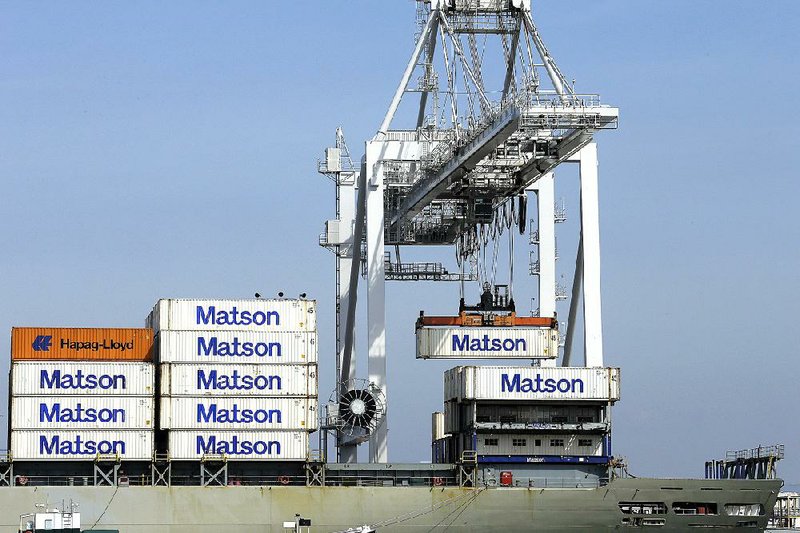WASHINGTON -- The U.S. trade deficit climbed in May as a surge in imports of Chinese-made cellphones and computers pushed the imbalance with China to the highest level in six months.
The trade deficit rose to $41.1 billion in May compared with April's $37.4 billion, the Commerce Department reported Wednesday. It was the largest imbalance since February. The trade deficit is the gap between the value of goods and services the United States imports from other countries and the smaller value of U.S. exports.
U.S. companies imported more cars, mobile phones, apparel and industrial supplies as the world's largest economy started to strengthen after a first-quarter lull. At the same time, overseas sales of U.S. goods face hurdles including weak global markets, with Britain's recent vote to leave the European Union further clouding the outlook.
"The re-acceleration in imports is in line with a firming in consumer spending in the second quarter," said Gregory Daco, head of U.S. macroeconomics at Oxford Economics Ltd. in New York. "We're continuing to see overall weakness in the export picture. That's a combination of a stronger currency and more importantly, a sluggish overseas growth environment."
Exports, which have struggled this year because of a strong dollar and weak growth in overseas markets, edged down 0.2 percent to $182.4 billion. Imports jumped 1.6 percent to $223.5 billion.
Jennifer Lee, senior economist at BMO Capital Markets, said the weakness in exports could become more pronounced in the coming months given the dollar's recent rise after the financial market turbulence caused by the vote in Britain.
"Given the way the greenback is headed, and quite likely slower growth in Europe, don't expect too much" from exports this year, she said in a note to clients.
A strong dollar makes American products more expensive in overseas markets. The dollar had been weakening slightly, but it has strengthened since the British vote as foreign investors have sought the safety of U.S. investments.
A wider U.S. trade deficit acts as a drag on growth because it means the nation is earning less on U.S. exports while spending more on imported products.
Jesse Hurwitz, an economist at Barclays Research, said the wider trade deficit was likely to trim overall growth by 0.5 percentage point in the second half of this year "as slower growth abroad and uncertainty following the U.K. referendum vote will likely lead to softer foreign demand for U.S. exports."
The U.S.' deficit with China jumped 19.4 percent to $29 billion, the largest imbalance since November. Presumptive Republican presidential nominee Donald Trump has accused President Barack Obama's administration of failing to protect U.S. workers from unfair trade practices in China and other countries.
Trump has sought to tap into the economic anxiety of Americans who have seen jobs disappear in an increasingly global economy. In a recent trade speech, Trump said he would exit from the North American Free Trade Agreement with Canada and Mexico if it were not renegotiated; kill the pending Trans-Pacific Partnership trade agreement; and take a more aggressive approach to China's trade practices, which he said were costing American jobs.
The U.S. Chamber of Commerce, normally an ally of Republicans on trade, said Trump's approach would cost 3.5 million U.S. jobs and result in higher prices for American consumers and a weaker economy. Trump said he would brand China a currency manipulator, an accusation that could lead to trade sanctions if negotiations with China did not resolve the issue.
Through the first five months of this year, the deficit ran 3.5 percent below the same period in 2015, a year in which the U.S.' deficit in goods and services trade rose 2.1 percent to $500.4 billion. The lower deficit so far this year reflects the fact that while U.S. exports are down, the value of imports is down by a larger amount, reflecting in large part lower oil prices.
For May, oil imports increased 8.4 percent to $11.1 billion, reflecting a rebound in prices during the month. The average price for a barrel of crude oil rose $4.71 to $34.19, the biggest one-month increase since a $5.55 rise from April to May in 2011.
Even with the gain, the average price for a barrel of crude is still $16.57 below the price from a year ago.
The deficit with China is running 6.4 percent below last year's pace, though it's still the largest gap the U.S. has with any single country.
The deficit with the EU rose 12.6 percent to $13.4 billion in May. The U.S.' trade relationship with the 28-nation EU could undergo a significant change if Britain goes ahead with its decision to leave the bloc.
Information for this article was contributed by Martin Crutsinger of The Associated Press and Shobhana Chandra of Bloomberg News.
Business on 07/07/2016
